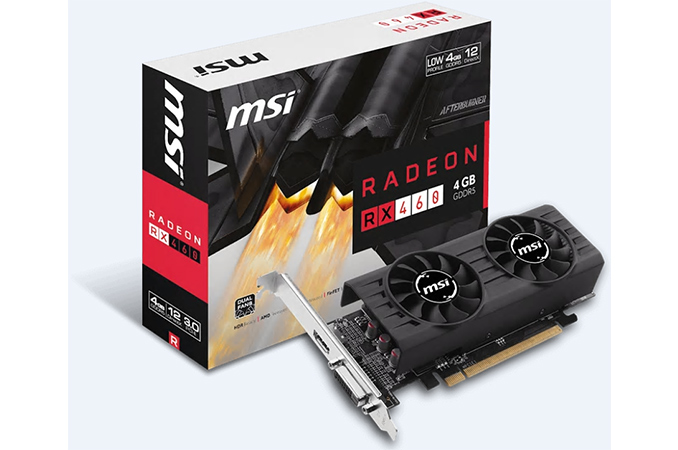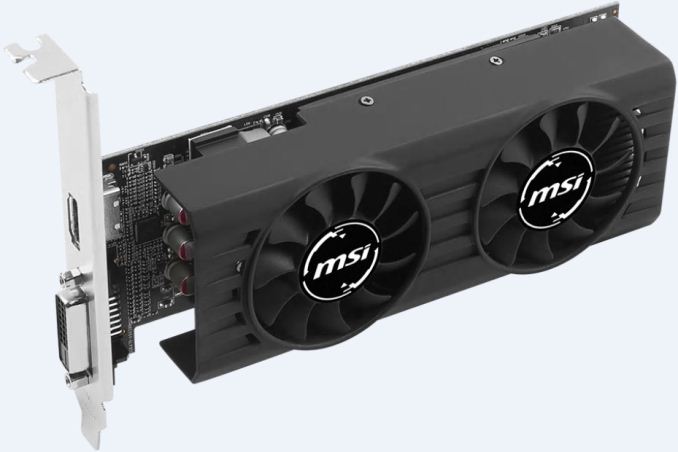MSI Adds Low-Profile AMD Radeon RX 460 Graphics Cards to Lineup
by Anton Shilov on February 18, 2017 1:00 PM EST- Posted in
- GPUs
- AMD
- Radeon
- MSI
- Polaris
- RX 460 4GT LP
- RX 460 2GT LP

MSI has quietly added two low-profile AMD Radeon RX 460 graphics adapters to its product family. The add-in-boards (AIBs) are powered by AMD’s latest entry-level GPU, Polaris 11. As these are base RX 460 models. they do not require PCIe power and are compatible with a wide range of computers that have enough space for a dual-slot card. The new adapters will be among the most affordable discrete graphics options today and will be aimed at those upgrading entry-level systems as well as building SFF HTPCs.
The MSI Radeon RX 460 4GT LP and Radeon RX 460 2GT LP are based on AMD’s Baffin (Polaris 11) graphics chip (896 stream processors, 56 texture units, 16 raster operations pipelines, 128-bit memory bus) clocked at up to 1.2 GHz (base/boost) and carry 2 or 4 GB of GDDR5 memory at 7 Gbps. As for connectivity, the boards have one DL-DVI-D and one HDMI 2.0 output with HDCP 2.2 support (HDCP 2.2 is required for playback of protected UHD video). When it comes to cooling, the AIBs use dual-slot cooling systems with two fans, the same as the company installed on other low-profile graphics cards. As an added bonus, MSI states that it uses MIL-STD-810G certified components to ensure a long lifespan for its LP adapters.
Over the past couple of months, MSI and a number of other companies (GIGABYTE, GALAX) have introduced low-profile graphics adapters based on NVIDIA’s GPUs - MSI is one of the first with similar LP RX 460 cards and extending its range of contemporary LP AIBs to four models. The addition of two low-profile cards to the lineup may indicate that demand for such products is relatively significant and rather stable.
Both AMD Polaris 11 (Baffin) and NVIDIA GP107 GPUs outperform integrated graphics cores of mainstream desktop CPUs and also support modern functionality like DirectX 12 and Vulkan APIs. Furthermore, the two graphics processors support hardware-accelerated decoding and encoding of HEVC (H.265) and VP9 video at 4Kp60 as well as HDR10. Finally, the GPUs consume up to 75 W of power and do not need any auxiliary PCIe power connectors, which makes them compatible with virtually all modern PCs with a PCIe 3.0 x16 slot, including those from various large brands that sometimes do not have any spare connectors left.
| MSI's Radeon RX 460 Low Profile Graphics Cards | ||||||
| RX 460 4GT LP | RX 460 2GT LP | |||||
| GPU | AMD Polaris 11 (Baffin) | |||||
| Stream Processors | 896 | |||||
| Texture Units | 56 | |||||
| ROPs | 16 | |||||
| Core Clock (MHz) | 1090 | |||||
| Boost Clock (MHz) | 1200 | |||||
| Memory | Capacity | 4 GB | 2 GB | |||
| Type | GDDR5 | |||||
| Clock | 7 Gbps | |||||
| Bus Width | 128 bit | |||||
| Outputs | DisplayPort | 0 | ||||
| DVI | 1 × DVI-D | |||||
| HDMI 2.0b | 1 | |||||
| TFLOPS (FP32) | 1.95 | |||||
| TDP | 75 W | |||||
| Launch Date | 2/2017 | 2/2017 | ||||
MSI has not announced MSRPs forthe new cards, and since the AIBs were added to the company’s product family in the last week, they are no yet available at Amazon or Newegg. Given the positioning of the adapters, it is unlikely that their price will be substantially different from $109 (2 GB version) and $139 (4 GB version) recommended by AMD.
Related Reading:















50 Comments
View All Comments
bill.rookard - Saturday, February 18, 2017 - link
DVI doesn't need to die. With a single port, and the right cable, a DVI-I can support:VGA monitor/projector. Use a passive DVI-A -> VGA adapter.
DVI-D monitor. Use a straight DVI-D cable.
DVI-A monitor. Use a straight DVI-A cable.
HDMI monitor. Use a DVI-D -> HDMI cable.
So - one port, 4 types of monitors.
Combine that with one display port and you can support any type of monitor out there, and if you wire the DVI port for sound, you can hook to any HDMI equipped TV as well. It's a very versatile port.
Yes, HDMI 2.0 is more forward looking, displayport has more support for higher resolutions, but not everyone is running a 4k60 monitor. Most people are using basic 1080p setups.
thomasg - Sunday, February 19, 2017 - link
This sounds good, but only on paper.VGA works, if the output device gives a VGA signal on the port (not guaranteed).
DVI-A is said VGA signal on the DVI port, no difference there (not guaranteed).
DVI-D <-> DVI-D generally works - except when either the input or the output or the cable can't do Dual-Link, in which case even this simplest of scenarios can give trouble. Luckily in reality there are virtually no DVI-A devices, so at least not more trouble there.
HDMI uses the same electrical signal as DVI-D, so it generally works - but of course not if DVI-A is used on the output, which is opaque to the user.
Lastly, few people know, that there are actually 2(!) DVI-D electrical signals. DVI-Video and DVI-PC. If one device only speaks DVI-Video and the other one DVI-PC (this is possible), colors won't match.
Lastly, while you can plug HDMI into DVI-D ports via an passive adapter, it won't support all HDMI features, which might be obvious to you and me, but not every user. For example, sound just won't work, when users expect it to work via HDMI on their TVs.
Long story short: DVI: 2 electrical signals, 4 different cables (1 of them universally DVI compatible), 4 different sockets (1 of them universally DVI compatible), basic but never full passive HDMI compatibility. No DisplayPort compatibility. No possible full HDMI compatibility via active adapter.
bananaforscale - Thursday, February 23, 2017 - link
Actually, DP and HDMI are electrically compatible (at least up to a point), so *5* different sockets.barleyguy - Sunday, February 19, 2017 - link
The analog DVI port is called DVI-I. A for analog of course makes more sense, but that doesn't mean you can make up your own acronyms and have them be correct. ;-)barleyguy - Sunday, February 19, 2017 - link
Addendum: Wikipedia claims that DVI-A does exist, but it's a DVI port with just analog and no digital. I'm not sure it actually exists in the wild.rtho782 - Monday, February 20, 2017 - link
HDMI needs to die before DVI. HDMI is far more limited, and was never intended to be a PC standard.But yes, the goal should be DP everywhere.
BrokenCrayons - Tuesday, February 21, 2017 - link
I disagree. HDMI is a lot more commonplace regardless of its non-PC origins. DP simply isn't everywhere and if we're going to consolidate around a single screen interface standard, HDMI already is a lot more heavily entrenched and DP is barely a blip on the display radar. In the end, common folk already familiar with HDMI will drive the direction of the industry, dooming DP to live in obscurity with BNC connectors and the Iomega Click drive.Manch - Wednesday, February 22, 2017 - link
Click Drive? That's not the gigantic purple disks is it? It's been a really really long time, but we used those plenty. BNC was never obscure. It was used plenty in the late 80's-mid 90's. Its still used today for some things albeit not it would be considered obscure.BrokenCrayons - Wednesday, February 22, 2017 - link
Well, it was actually marketed under the name Clik! but even I didn't remember it accurately. Here's the Wikipedia entry for it.https://en.wikipedia.org/wiki/PocketZip
I first got my hands on one at a trade show. The Iomega sales folks were offering trinkets and I asked for the PCMCIA version and a couple of disks to show to clients. The drive never took off and ended up a lot like the LS-120/240 (though I still argue the LS-120 was much more useful and practical since it could also replace the 3.5 inch floppy drive).
bananaforscale - Thursday, February 23, 2017 - link
You could say HDMI is more commonplace *thanks to* its non-PC origins.